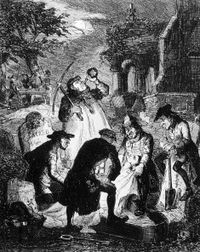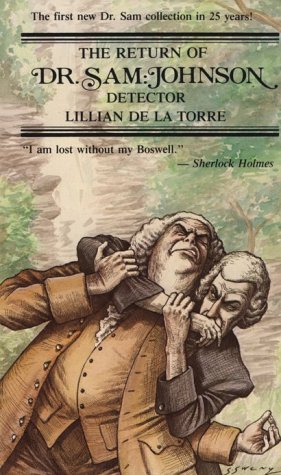This volume represents a move forward for de la Torre and Johnson; one story is copyright 1947, and the rest are from the 70s. I have no idea why there was the break of a couple decades, but there it is.
There's also a move from sheer detection to a more adventurous slant. The stories aren't as much Johnson using his sharp senses to detect a crime, but acting as a sort of Simon Templar-ish gentleman adventurer tackling some evil of the day. Still, they're good reading.
This is also the first volume of the series I ever read; I remember coming across it at a used book sale while I was in college in the mid-80s.
And so, on to the stories...
"Murder Lock'd In" (London, 1763) is a locked-room mystery taking place just as Johnson and Boswell are meeting and getting to know each other. An old lady and her maid are killed, and the room is locked (or lock'd) from the inside. There's been a robbery, but are the culprits for that responsible for the deaths? What makes this so interesting is that it's more or less a true story, a real murder and robbery that ended in a girl's hanging, that happened in that year, but Johnson was not involved.
"The Bedlam Bam" (London, 1768; the term "bam" is an abbreviation for "bamboozle") is an adventure tale. Johnson and Boswell go to visit a crusading parson who feigned madness to get committed to Bethlehem Royal Hospital (aka Bedlam) to experience their treatment of the mad first-hand. However, a scheming relative of the parson plans to keep him inside, and thus control the parson's money and beautiful daughter. Johnson hatches a scheme to get him out, and leads the forces of evil on a merry chase.
"The Disappearing Servant Wench" (London, year is not clear) is a fictionalization of the real-life Elizabeth Canning case, of which de la Torre wrote a full-length treatment in another book. A servant girl disappears, then shows up a month later, much the worse for wear, with a vivid story of kidnapping and forced prostitution. However, an investigation of the place where she claimed to have been held prisoner clicks in some ways with her story, but with some glaring inconsistencies. Was she really abducted? Is she lying? De la Torre offers an interesting solution that she claims came to her in a dream.
 | |
| Canning the dock. |
Next up is another topical adventures, "The Blackamoor Unchain'd," set in 1772, when Johnson and Boswell strike a blow against the slave trade. An escapee from a West Indian slave ship is hiding out with Johnson's black servant, and although there's no slavery in England, there's still complicated laws supporting the rights of slave owners from other countries. But the team plan to get the friend free, and barely manage to do so before the ship sets sail again. This at least gives some background to Johnson's grousing against the Americans at the time; he saw the irony of a slave-owning nation making a big deal about "freedom." We get to meet noted abolitionist Granville Sharp, and hear a stirring slogan, "The air of England has long been too pure for a slave, and every man is free who breathes it!"
"The Lost Heir," dating from 1773, is de la Torre's fictional treatment of the controversy surrounding the Tichborne Claimant, a real case from the 1860s. A noble widow mourns her long-lost son, and suddenly a man is found claiming to be him. However, there's some remarkable differences, and he doesn't seem to know some things he should...but other private facts are known to him, and he has the right look. What's his story? What's the truth? Sadly, the solution to the story is a bit too easy, and it doesn't fit the facts of the real case, so de la Torre's proposed solution to the real case doesn't hold water.
"The Resurrection Men" looks at another criminal problem of the period, grave-robbing. Set in an indeterminate time (but possibly 1784), it has Johnson helping a grieving mother whose late husband's body was stolen by resurrectionists, and who now fears her late son's body will suffer the same fate. But Johnson has a plan, and sets a trap for the grave robbers and their confederate...
 |
| Real resurrection men, plying their trade. |
Finally, "Milady Bigamy" is based on the real-life bigamy trial of Elizabeth Pierrepont, Duchess of Kingston-upon-Hull in 1778. It's a tale of light detection as Bellona Chamleigh, the Duchess of Kingston, is defending her name against a charge of bigamy. Although the real case ended in a guilty verdict (with the real Duchess escaping the branding iron by "pleading her clergy," i.e. proving she could read and write, which by an antiquated legalism got her off), the fictional case ends quite differently.
As with de la Torre's other stories, they're all good fun and dripping with historic atmosphere, and worth seeking out.





No comments:
Post a Comment